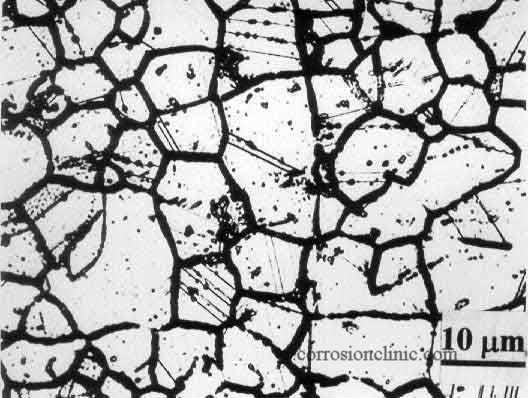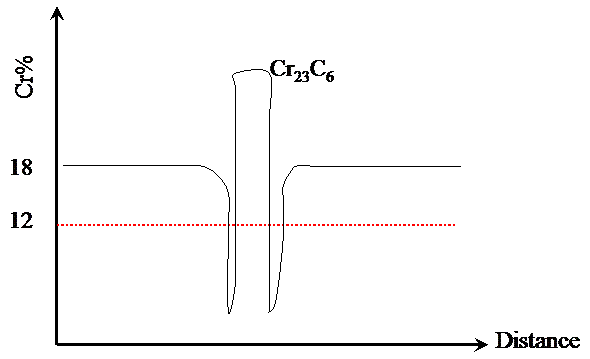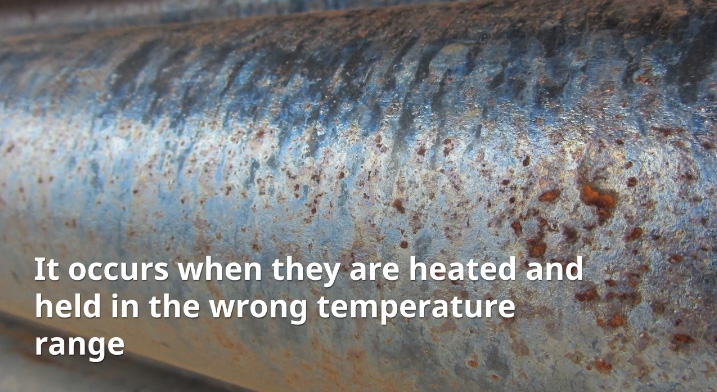Intergranular Corrosion
Intergranular corrosion is sometimes also called "intercrystalline corrosion" or "interdendritic corrosion". In the presence of tensile strength, cracking may occur along grain boundaries and this type of corrosion is frequently called "interranular stress corrosion cracking (IGSCC)" or simply "intergranular corrosion cracking". Such precipitation can produce zones of reduced corrosion resistance in the immediate vicinity.
The microstructure of metals and alloys is made up of grains, separated by grain boundaries. Intergranular corrosion is localized attack along the grain boundaries, or immediately adjacent to grain boundaries, while the bulk of the grains remain largely unaffected. This form of corrosion is usually associated with chemical segregation effects (impurities have a tendency to be enriched at grain boundaries) or specific phases precipitated on the grain boundaries.
The attack is usually related to the segregation of specific elements or the formation of a compound in the boundary. Corrosion then occurs by preferential attack on the grain-boundary phase, or in a zone adjacent to it that has lost an element necessary for adequate corrosion resistance - thus making the grain boundary zone anodic relative to the remainder of the surface. The attack usually progresses along a narrow path along the grain boundary and, in a severe case of grain-boundary corrosion, entire grains may be dislodged due to complete deterioration of their boundaries. In any case the mechanical properties of the structure will be seriously affected.
A classic example is the sensitization of stainless steel or weld decay. Chromium-rich grain boundary precipitates lead to a local depletion of Cr immediately adjacent to these precipitates, leaving these areas vulnerable to corrosive attack in certain electrolytes. Reheating a welded component during multi-pass welding is a common cause of this problem. In austenitic stainless steel, titanium or niobium can react with carbon to form carbides in the heat affected zone (HAZ) causing a specific type of intergranular corrosion known as knife-line attack. These carbides build up next to the weld bead where they cannot diffuse due to rapid cooling of the weld metal. The problem of knife-line attack can be corrected by reheating the welded metal to allow diffusion to occur.
Many aluminum base alloys are susceptible to intergranular corrosion on account of either phases anodic to aluminum being present along grain boundaries or due to depleted zones of copper adjacent to grain boundaries in copper-containing alloys.Alloys that have been extruded or otherwise worked heavily, with a microstructure of elongated, flattened grains, are particularly prone to this damage.
"Intergranular" or 'intercrystalline" means between grains or crystals. As the name suggests, this is a form of corrosive attack that progresses preferentially along interdendritic paths (the grain bourdaries). Positive identification of this type of corrosion usually requires microstructure examination under a microscopy although sometimes it is visually recognizable as in the case of weld decay.
 
The photos above show the microstructure of a type 304 stainless steel. The figure on the left is the normalized microstructure and the one on the right is the "sensitized" structure and is susceptible to intergranular corrosion or intergranular stress corrosion cracking.
What causes intergranular corrosion?
This type of attack results from local differences in composition, such as coring commonly encountered in alloy castings. Grain boundary precipitation, notably chromium carbides in stainless steels, is a well recognized and accepted mechanism of intergranular corrosion. The precipitation of chromium carbides consumed the alloying element - chromium from a narrow band along the grain boundary and this makes the zone anodic to the unaffected grains. The chromium depleted zone becomes the preferential path for corrosion attack or crack propagation if under tensile stress.
• Electrochemical conditions in which intergranular corrosion occurs
(1) The crystal grains and the grain boundary regions have different structures, and thus there are significant differences in electrochemical properties. —— ——Inner causes
(2) Differences in grain and grain boundaries should be revealed in an appropriate environment. ———— External causes
Sensitization heat treatment
Intergranular corrosion of stainless steel often occurs after an incorrect heat treatment, and the heat treatment that causes the intergranular corrosion tendency of stainless steel is called sensitization heat treatment. The sensitization heat treatment range of austenitic stainless steel is 450 ° C - 850 ° C. When austenitic stainless steel is heated (such as welding) or slowly cooled in this temperature range for a long time, intergranular corrosion sensitivity is generated. The sensitization temperature of ferritic stainless steel is above 900 °C, and annealing at 700-800 °C can eliminate the tendency of intergranular corrosion.

Intermetallics segregation at grain boundaries in aluminum alloys also causes intergranular corrosion but with a different name - "exfoliation".

How to prevent intergranular corrosion?
Intergranular corrosion can be prevented through:
- Use low carbon 0.035% max (e.g. 304L, 316L, 317L or 904L) grade of stainless steel tube
- Use stabilized grades alloyed with titanium (for example type 321) or niobium (for example type 347). Titanium and niobium are strong carbide- formers. They react with the carbon to form the corresponding carbides thereby preventing chromium depletion.
- Use post-weld heat treatment.
- Proper Solution Annealing, Solution anneal above 1040 ° C (1900° F) followed by a rapid Quench. avoid sensitization heat treatment.

Metallographic Test - Metallography Testing
Metallographic Test Report
Stress Corrosion Cracking (SCC)
Chloride Stress Corrosion Cracking
Stainless Steel Corrosion
Corrosion of Piping
Corrosion Process
Surface Coatings for Corrosion
Corrosion Resistant Material
Bi- Metallic Corrosion.Galvanic Corrosion
Intergranular Corrosion
Intergranular Corrosion of Stainless Steel Tubes
Corrosion Resistant Stainless Steel Tube
Corrosion Resistance of Stainless Steel Tubes
Seawater Resistance of Stainless Steel Tubes
Corrosion Mechanism in Stainless Steel Tube
ASTM A262 Intergranular Corrosion Test IGC
ASTM E112 Standard Test Methods for Determining Average Grain Size
Methods of minimizing chloride stress corrosion cracking
|
